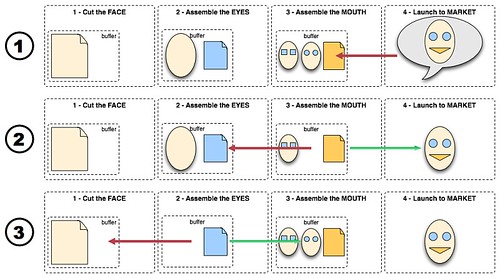In this session, Joshua Kerievsky (the founder of Industrial Logic and author of “Refactoring to Patterns”) shared his experiences about stepping away from using estimations and moving into what he called ‘Micro-releases’. What got me interested is that, although he claimed not to be following the recent kanban/iteration-less techniques, he arrived in something relatively similar through his own experiences.
He started talking about the usual confusion of using different units to estimate stories (using points and people converting it into time-units when estimating, using ideal hours and people interpreting it as real hours, and so on). This confusion is also reflected in the way people interpret the team’s velocity. Instead of using it as a measure of the team’s capacity, it’s easy to make it a performance measure. Improving velocity becomes a synonym to improving productivity, and we still don’t know how to measure productivity in software.
Another usual problem that he raised is “What to do with hang-over stories between iterations?”. Are they considered waste? Should they be counted in the team’s velocity? Why is it a hang-over? Is it because it’s close to be completed or is it actually much bigger than the team expected?
His proposed practice of ‘micro-releases’ is based on a high state of collaboration with the customer: there is a small, prioritized list of what should be done next and the team picks up a small and coherent set of stories and ‘guess’ the next micro-release date based on gut feel. He reports that slipping the end date of a micro-release is not such a big deal, because the next one is always close. In this model, the length of a micro-release varies, but usually between 1-6 days (with some outliers like 15, as I recall from his slides, but it’s not too different than that). Because of that, there’s not a stable measure of velocity and using it becomes useless. Feeding the input list with the next stories is done in a just-in-time fashion, and the value produced by the software is realized earlier, as soon as the micro-release is finished.
It’s important to note that he still values the heartbeat of iterations to gather feedback (like a customer showcase or a team’s retrospective). But he simply detaches the release life-cycle from the iterations. This opinion was reinforced by Ron Jeffries in the audience, when he said they were releasing to production twice per iteration in one of his projects. What an interesting point of view: we usually tend to see a ‘release’ as the result of a set of ‘iterations’, but he is reporting smaller ‘release’ cycles than ‘iterations’. Hmm…
But there are some important caveats that should be in place in order for these techniques to work:
- High collaboration with the customer
- Ability to break-down stories into small-but-still-valuable chunks: He reckons it’s very important to know how to break down requirements into “stories of the right size”. If they are too big, there’s no way for the team to guesstimate when they will be finished. He thinks this practice is one of the most important to any Agile project (using micro-releases or not).
- Easy to deploy: There’s no point in having a new release after 2 days if it takes 3 days to deploy it to production.
- Bargaining stories: Alongside breaking stories into small chunks, teaching the customer to bargain for features and avoid what he calls “Feature Fat” (building more that’s actually needed, or gold-plating requirements) is very important (again, this is something you can use regardless of the micro-releases approach).
Since the experiences started with Idustrial Logic’s internal product development, some people argued they are only capable of using that because they have enough experience with XP and Agile, but Joshua claimed he is introducing these ideas with success in their new client projects.
This seems like a common theme in the agile space lately, and you can follow up on the discussions on InfoQ, the XP mailing list, or here. :-)
I’ve found out recently that there’s an interesting timeless statement in the Agile Manifesto that we usually forget: “We are uncovering better ways of developing software…”. We should be open to alternatives and to discuss new ideas!



 Twitter
Twitter LinkedIn
LinkedIn Facebook
Facebook Flickr
Flickr